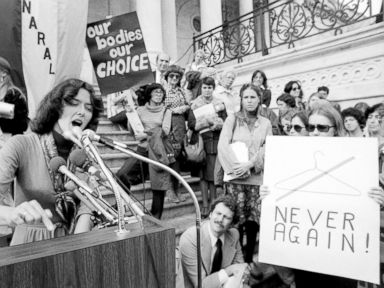
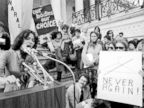

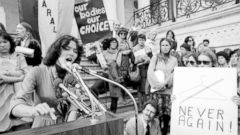
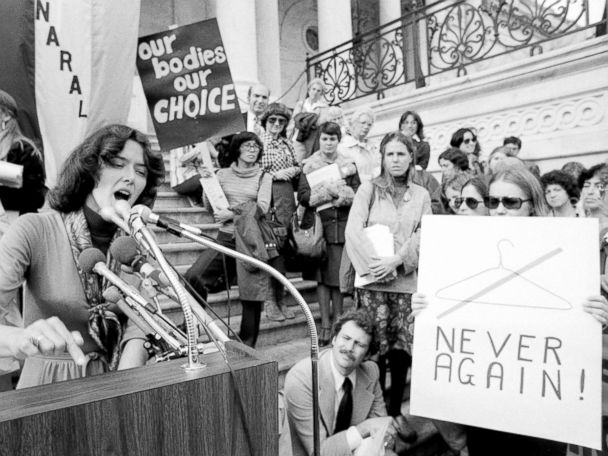
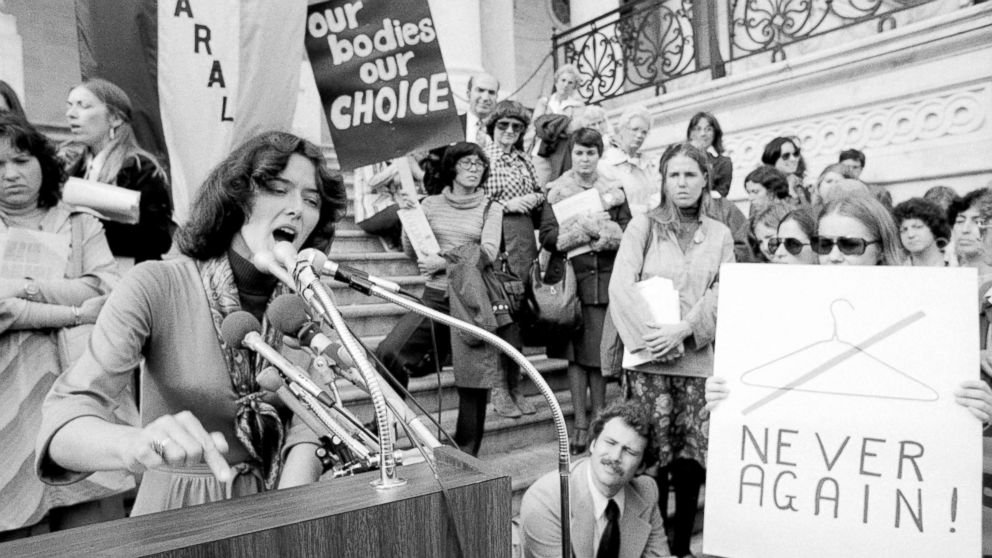

For more than 50 years, Adele Zimmermann never talked about what happened in her apartment that day in 1965.
Blindfolded and scared, Zimmerman, then 23, waited for the man “more mobster than medical,” she said, to finish performing the abortion. He had insisted on the blindfold and in speaking in a soft voice so he could not be identified.
She had paid him $100 to end her pregnancy.
Zimmerman was from a Catholic family, she was unmarried and she was about three months pregnant when she didn’t want to be. And although she was just across Buffalo from her entire family, Zimmermann told none of them her fears over the next several days that the unstoppable bleeding she was experiencing might kill her.
“It was probably one of the most alone times I’ve ever had,” Zimmermann said, her voice breaking with emotion 53 years later. “Damn, I was scared. The bleeding wouldn’t stop. I didn’t know how to stop it. I didn’t know what would happen. And I was one of the lucky ones, I survived. A lot of women did not survive, or they developed horrible complications, complications that ruined their health.”
Zimmermann, now 75, said she is speaking out about her illegal abortion because she fears that the Trump administration is trying to take the country back to those times by overturning or undermining Roe v. Wade, the landmark 1973 Supreme Court case that legalized abortion.
Trump has nominated conservative judge Brett Kavanaugh to the Supreme Court, who has expressed his support for the dissenting opinion on Roe and in the case of a teenage girl who sought to end her pregnancy while in a government-run shelter for immigrants in Texas, the Associated Press reported.
In 2006, Kavanaugh told lawmakers he “would follow Roe v. Wade faithfully and fully” as a binding precedent of the court.
“If confirmed to the D.C. Circuit, I would follow Roe v. Wade faithfully and fully,” he said in response to a question by Sen. Chuck Schumer, D-N.Y. “It’s been decided by the Supreme Court.
Trump, for his part, said last month that he hadn’t discussed abortion with Kavanaugh, CNN reported.
Still, abortion advocates fear Kavanaugh would work with the court’s other conservative justices to overturn it.
“This is the rhetoric from the anti-abortion groups being used by a potential Supreme Court justice, and that really gives us pause,” Jacqueline Ayers, the national director of legislative affairs for Planned Parenthood Federation of America, told the AP.
Even if Roe isn’t overturned, it could be weakened to the point that it makes abortion virtually impossible for women in certain states to access, said Elizabeth Nash, the senior state issues manager at the Guttmacher Institute, a reproductive rights research group that was initially formed under Planned Parenthood but has been operating separately for years. State-level restrictions in some states are already making that happen, she added.
“For abortion rights, this is a really scary time. Because we could see our ability to access abortion become undercut or completely taken away. And what that would do — in either case, overturning or undercutting — it would really exacerbate what we are seeing at the state level,” Nash said.
Such restrictions are taking abortion access back to the time before Roe when only some states made abortion legal and only in some instances. Nash said that today, while abortion remains relatively easy to access in the Northeast and on the West Coast, there are regions in the South and middle of the country where clinic closures, mandatory waiting periods and other restrictions have made it very difficult for women.
“If Roe were to be overturned or undercut, that disparity in access would increase,” Nash said. “We would see states that are politically hostile to abortion rights move ahead on restrictions and bans, and other states do what they can to maintain abortion access.”
Before nominating Kavanaugh in early July, Trump did not rule out the idea that his eventual pick could be instrumental in the future of Roe v. Wade, saying abortion could be something that is decided state by state in the future.
“You never know how that’s going to turn out,” Trump said. “That’s a very complex question. The Roe v. Wade is probably the one that people are talking about in terms of having an effect, but we’ll see what happens. But it could very well end up with states at some point.”
Growing up in the 1950s in a Catholic family and attending Catholic school, Zimmermann said that she never received any sexual education.
“We were taught about how algae reproduced, and that qualified as sex ed,” she said.
As a child, she didn’t know exactly how people became pregnant, she said, but she knew from an early age that she didn’t want to be a mother.
“I decided a long time ago that I didn’t want children,” Zimmermann said. “When I opened the Dick and Jane reader in first grade and looked at momma’s role, I thought, no way. It was different then. It was horrible, at least to someone like me.”
“Not many women worked outside the home. Their responsibilities were centered around the home, and of course, men were dominant. It was accepted that women were inferior, and boy did that piss me off,” Zimmermann said. “I was a feminist long before the word was ever widely publicized. It isn’t that I didn’t like being a girl or dressing up or playing with dolls, but I wanted what boys had, too.”
That included a job outside the home and the chance to be a scientist. But the message she received at school was very different.
“Girls shouldn’t be smart, boys won’t like that if you’re too smart, and I was smart and I didn’t hide it,” Zimmermann said.
She graduated from high school and enrolled in a Jesuit college in Syracuse. She dropped out after two years and was living and working in Buffalo when she found out she was pregnant, she said.
“I became sexually active without realizing how easy it was to get pregnant. It was kind of a semi-relationship and even to do the pregnancy test, I used a pseudonym and I went to a doctor I didn’t know, I dropped off my urine sample in his office and I got the results by phone,” Zimmermann said. “I was terrified. I lived in the same city as my family and my family was Catholic, and with all the outside social pressures on out-of-wedlock children — there was that to consider — I panicked. A friend said he knew someone who could help me.”
The man came to her apartment to perform the abortion, she said, an environment that was far from sterile and medically safe. When it was over, no one told her what she should expect or how she should care for herself.
“The guy helped me lose the baby but I bled for days and I didn’t realize what kind of danger I was in,” Zimmermann said, holding back tears. “I was afraid to go to a doctor. I didn’t know what the penalty was, I knew abortion was illegal, I didn’t know the laws and I didn’t want my family to find out. I wasn’t completely alone, I had a couple of friends who checked up on me. But it was a horrible time and God, it can’t happen like that anymore. It just can’t.”
To be sure, modern medical technology has also changed how abortions are performed since the 1970s. Early abortions can be performed with medication, lessening the need for surgical abortions. Surgical abortions performed in abortion clinics involve sterile instruments and registered medical professionals, unlike illegal abortions in the past.
Zimmermann, meanwhile, went on to collect the experiences she treasures today: she heard John F. Kennedy speak, she became politically active, she was a beatnik, she moved to New York City and then to New Mexico. She became a computer scientist and worked in the field she loved. She said she would never have shared the story of her abortion while her parents were alive because “it would hurt them and I couldn’t do that.” But as the rhetoric about overturning Roe heated up, she decided that had to change.
“It’s only in the last decade that this assault on our rights has happened,” Zimmermann said. “I’m 75, what do I have to lose?”
She wrote an essay for Cosmopolitan last fall and has since had her letters to the editor published in her local paper.
“My theory is that it isn’t about respect for fetuses or religion, it’s trying to put the genie back in the bottle, and women are the genies,” she said. “Because if you can’t control your reproduction, what are your career choices? You become dependent on men, which is what they want.”
Zimmermann isn’t the only older woman speaking out about life before Roe v. Wade. At a protest this week, several dozen women of all ages dressed in the robes of “The Handmaid’s Tale” to protest the Trump administration’s stance on abortion and family separation outside an event where Vice President Mike Pence and Department of Homeland Security Secretary Kirstjen Nielsen were speaking.
“The Handmaid’s Tale,” first published by Margaret Atwood in 1985 and made into a Hulu drama in 2017, focuses on the Republic of Gilead, a religious society in which fertile women are forced to bear the children of political leaders after losing their rights to property, money, their bodies and custody of their own children. Tuesday’s protest was organized by Refuse Fascism, which staged a similar demonstration in Philadelphia earlier this month.
Marion Marino, 84, was one of the protesters who dressed as handmaids. She said she remembers what it was like when abortion was illegal.
“A very good friend of mine had to have an abortion in this state when it was illegal,” Marino said. “She had to go through the mafia, she had to pay a great deal of money to have the abortion. Luckily, she went through an illegal abortion with a legal doctor and was okay afterwards, but it was certainly not something she wanted anyone else to go through.”
“In New York state, abortion was a crime. If a woman had an abortion, she went through both emotionally and physically what she needed to go through, and after she had the abortion, she could be arrested,” Marino added. “Women were dying, women were trying to create abortions on their own using coat hangers and things like that. Everyone thought it was a terrible thing and it was wrong, but abortion has gone on in every country, all through time. All kinds of things have been done to create abortion. And for this to be taken away from us after all the fighting we have done to get these rights — it’s really important to me.”
Lillian Forman, 82, also protested as a handmaid Tuesday.
“I thought I needed an abortion when it was just legalized, as it turned out, I didn’t need it. But I was glad that the possibility was there,” Forman said. “It would have been catastrophic for me.”
Marino said she “never” thought she would be out in the streets in 2018 trying to save Roe v. Wade.
“After the women’s movement, Gloria Steinem and all those brave and important and articulate women, I thought that the fight was over,” Marino said. “And then we got Trump in office and it’s all disappearing now.”
Forman agreed, adding that young people must be aware of what they could lose if Roe were to be overturned.
“This is their future, and they have to wake up to what’s happening,” Forman said.
State-level restrictions have caused abortion clinics to close across the country even before Trump took office, according to the Guttmacher Institute. Iowa, Louisiana, and Arkansas are three states where multiple abortion clinics have closed, and those states have also proposed new laws that would shorten the time frame that women have to seek legal abortions.
Before the Roe v. Wade decision, states had their own abortion laws, making access uneven, Nash said.
“You had 13 states, ranging from California to Kansas, that had made it a little easier to get an abortion. And then you had four states that had really liberalized their abortion laws,” Nash said.
New York was among the first states to liberalize its abortion laws in the 1970s, Nash said, and some women who could afford to travel there to have an abortion did.
“That was really a game changer for access because there were a lot of barriers, but a number of people went to New York to get an abortion because it was unavailable in their state,” Nash said. “So it wasn’t just in 1973 that the Supreme Court that decided that abortion should be legal. There was a longstanding groundswell. But it was uneven progress.”
But then, like now, the disparity in who could afford to travel to a clinic existed. Clinic closures and waiting periods often make it harder for poor women and women of color to exert their right to have an abortion, Nash added, making it uneven progress once again.
Zimmermann said the combination of a lack of control over their fertility and negative attitudes toward single mothers made things “horrible” for women before Roe v. Wade.
“When I had an apartment in downtown Buffalo, down the street was a home for unwed mothers, and they just would slink around the neighborhood,” Zimmermann said. “When I was in my 20s, a friend of mine had a baby out of wedlock and the hospital wouldn’t even acknowledge that she was there. And ‘bastard’ was used to describe children born out of wedlock, not the way it’s used now, where it’s thrown around at anyone you don’t like.”
Attitudes have changed a lot, she said, and it can be hard for young women today to understand just how limiting things were then. Zimmermann said having an abortion was the right decision for her.
“It’s been a good life and I am now comfortable with who I am and how I’ve lived,” she said. “Saddled with an unwanted child at age 23 in a society that did not support that, I might not be alive now. I have suffered off and on with depression most of my life, and I probably would have succumbed to it.”
For Zimmermann, sharing the story of her abortion is also about learning more about her own life.
“I needed to unravel my own life, I needed to follow all the strands of my life to figure out how I got here to be who I am and what I am. I needed to be comfortable with who I am now and how I lived my life,” she said. “You can’t do that without following all the little strands.”

